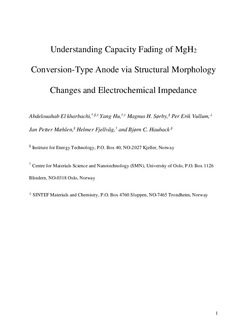Understanding Capacity Fading of MgH2 Conversion-Type Anodes via Structural Morphology Changes and Electrochemical Impedance
El-Kharbachi, Abdelouahab; Hu, Yang; Sørby, Magnus Helgerud; Vullum, Per Erik; Mæhlen, Jan Petter; Fjellvåg, Helmer; Hauback, Bjørn
Journal article, Peer reviewed
Accepted version
Permanent lenke
http://hdl.handle.net/11250/2579792Utgivelsesdato
2018Metadata
Vis full innførselSamlinger
- Institutt for fysikk [2653]
- Publikasjoner fra CRIStin - NTNU [37219]
Originalversjon
Journal of Physical Chemistry C. 2018, 122 (16), 8750-8759. 10.1021/acs.jpcc.7b12656Sammendrag
Previous studies have demonstrated that MgH2 is a promising conversion-type anode toward Li with high capacity (2037 mAh/g) and low discharge/charge overpotential hysteresis. A major challenge is the capacity loss after a few cycles. To improve the understanding of the complex conversion mechanism at the electrode/electrolyte interface and of its possible evolution, a systematic investigation of the morphology–property relation is undertaken. A multitude of MgH2 materials are obtained by mechanical milling using different devices, milling conditions, and time intervals. Upon cycling, the performance of the assembled batteries is strongly dependent on the quality of the prepared MgH2 powders. Electrochemical discharge/charge profiles (MgH2 ⇆ 2LiH + Mg) are discussed according to the changes in microstructure and morphology revealed by powder X-ray diffraction and transmission electron microscopy. For all electrode composites, the loss of the capacity occurs typically during delithiation in agreement with a kinetically limited process, namely, of LiH “detachment”. Electrochemical impedance spectroscopy is meaningfully carried out using the representative tape-casted electrodes in Li/MgH2 cells to monitor the evolution of resistance components, in particular the formation of a solid electrolyte interphase (SEI)-like layer as a function of particle size, state of charge, and cycle number.
